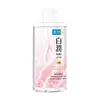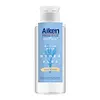What's inside
What's inside
 Key Ingredients
Key Ingredients

 Benefits
Benefits

 Concerns
Concerns

 Ingredients Side-by-side
Ingredients Side-by-side

Water
Skin ConditioningGlycerin
HumectantPEG-7 Caprylic/Capric Glycerides
EmulsifyingPropanediol
SolventPEG-6 Caprylic/Capric Glycerides
EmulsifyingSodium Cocoamphoacetate
CleansingChlorphenesin
AntimicrobialPEG/PPG/Polybutylene Glycol-8/5/3 Glycerin
HumectantXylitylglucoside
HumectantPolyaminopropyl Biguanide
PreservativeSodium Chloride
MaskingAnhydroxylitol
HumectantDisodium EDTA
Xylitol
HumectantSodium Hyaluronate
HumectantPhytic Acid
3-O-Ethyl Ascorbic Acid
Skin ConditioningSalicylic Acid
MaskingPotassium Azeloyl Diglycinate
Skin ConditioningAmylopectin
Dextrin
AbsorbentXanthan Gum
EmulsifyingButylene Glycol
Humectant1,2-Hexanediol
Skin ConditioningPhenoxyethanol
PreservativePentylene Glycol
Skin ConditioningPolyquaternium-10
Hydrolyzed Sodium Hyaluronate
Skin ConditioningMoringa Oleifera Seed Extract
Skin ConditioningBiosaccharide Gum-4
Skin ConditioningDisodium Phosphate
BufferingPotassium Chloride
Citric Acid
BufferingCaprylyl Glycol
EmollientWater, Glycerin, PEG-7 Caprylic/Capric Glycerides, Propanediol, PEG-6 Caprylic/Capric Glycerides, Sodium Cocoamphoacetate, Chlorphenesin, PEG/PPG/Polybutylene Glycol-8/5/3 Glycerin, Xylitylglucoside, Polyaminopropyl Biguanide, Sodium Chloride, Anhydroxylitol, Disodium EDTA, Xylitol, Sodium Hyaluronate, Phytic Acid, 3-O-Ethyl Ascorbic Acid, Salicylic Acid, Potassium Azeloyl Diglycinate, Amylopectin, Dextrin, Xanthan Gum, Butylene Glycol, 1,2-Hexanediol, Phenoxyethanol, Pentylene Glycol, Polyquaternium-10, Hydrolyzed Sodium Hyaluronate, Moringa Oleifera Seed Extract, Biosaccharide Gum-4, Disodium Phosphate, Potassium Chloride, Citric Acid, Caprylyl Glycol
Water
Skin ConditioningPropanediol
SolventPEG-6 Caprylate/Caprate
EmulsifyingPEG-7 Glyceryl Cocoate
EmulsifyingOlive Oil PEG-7 Esters
EmollientBetaine
HumectantSodium PCA
HumectantGlycerin
HumectantDisodium EDTA
Sodium Citrate
BufferingXanthan Gum
EmulsifyingSodium Hyaluronate
HumectantCitric Acid
BufferingButylene Glycol
HumectantAlpha-Glucan Oligosaccharide
CleansingPolymnia Sonchifolia Root Juice
Skin ConditioningAspergillus Ferment
Skin ConditioningMaltodextrin
AbsorbentLactobacillus
Skin ConditioningPhenoxyethanol
PreservativeChlorphenesin
AntimicrobialWater, Propanediol, PEG-6 Caprylate/Caprate, PEG-7 Glyceryl Cocoate, Olive Oil PEG-7 Esters, Betaine, Sodium PCA, Glycerin, Disodium EDTA, Sodium Citrate, Xanthan Gum, Sodium Hyaluronate, Citric Acid, Butylene Glycol, Alpha-Glucan Oligosaccharide, Polymnia Sonchifolia Root Juice, Aspergillus Ferment, Maltodextrin, Lactobacillus, Phenoxyethanol, Chlorphenesin
 Reviews
Reviews

Ingredients Explained
These ingredients are found in both products.
Ingredients higher up in an ingredient list are typically present in a larger amount.
Butylene Glycol (or BG) is used within cosmetic products for a few different reasons:
Overall, Butylene Glycol is a safe and well-rounded ingredient that works well with other ingredients.
Though this ingredient works well with most skin types, some people with sensitive skin may experience a reaction such as allergic rashes, closed comedones, or itchiness.
Learn more about Butylene GlycolChlorphenesin is a synthetic preservative. It helps protect a product against bacteria in order to extend shelf life. In most cases, Chlorphenesin is paired with other preservatives such as phenoxyethanol and caprylyl glycol.
Chlorphenesin is a biocide. This means it is able to help fight the microorganisms on our skin. It is also able to fight odor-releasing bacteria.
Chlorphenesin is soluble in both water and glycerin.
Studies show Chlorphenesin is easily absorbed by our skin. You should speak with a skincare professional if you have concerns about using Chlorphenesin.
Learn more about ChlorphenesinCitric Acid is an alpha hydroxy acid (AHA) naturally found in citrus fruits like oranges, lemons, and limes.
Like other AHAs, citric acid can exfoliate skin by breaking down the bonds that hold dead skin cells together. This helps reveal smoother and brighter skin underneath.
However, this exfoliating effect only happens at high concentrations (20%) which can be hard to find in cosmetic products.
Due to this, citric acid is usually included in small amounts as a pH adjuster. This helps keep products slightly more acidic and compatible with skin's natural pH.
In skincare formulas, citric acid can:
While it can provide some skin benefits, research shows lactic acid and glycolic acid are generally more effective and less irritating exfoliants.
Most citric acid used in skincare today is made by fermenting sugars (usually from molasses). This synthetic version is identical to the natural citrus form but easier to stabilize and use in formulations.
Read more about some other popular AHA's here:
Learn more about Citric AcidDisodium EDTA plays a role in making products more stable by aiding other preservatives.
It is a chelating agent, meaning it neutralizes metal ions that may be found in a product.
Disodium EDTA is a salt of edetic acid and is found to be safe in cosmetic ingredients.
Learn more about Disodium EDTAGlycerin is already naturally found in your skin. It helps moisturize and protect your skin.
A study from 2016 found glycerin to be more effective as a humectant than AHAs and hyaluronic acid.
As a humectant, it helps the skin stay hydrated by pulling moisture to your skin. The low molecular weight of glycerin allows it to pull moisture into the deeper layers of your skin.
Hydrated skin improves your skin barrier; Your skin barrier helps protect against irritants and bacteria.
Glycerin has also been found to have antimicrobial and antiviral properties. Due to these properties, glycerin is often used in wound and burn treatments.
In cosmetics, glycerin is usually derived from plants such as soybean or palm. However, it can also be sourced from animals, such as tallow or animal fat.
This ingredient is organic, colorless, odorless, and non-toxic.
Glycerin is the name for this ingredient in American English. British English uses Glycerol/Glycerine.
Learn more about GlycerinPhenoxyethanol is a preservative that has germicide, antimicrobial, and aromatic properties. Studies show that phenoxyethanol can prevent microbial growth. By itself, it has a scent that is similar to that of a rose.
It's often used in formulations along with Caprylyl Glycol to preserve the shelf life of products.
Propanediol is an all-star ingredient. It softens, hydrates, and smooths the skin.
It’s often used to:
Propanediol is not likely to cause sensitivity and considered safe to use. It is derived from corn or petroleum with a clear color and no scent.
Learn more about PropanediolSodium Hyaluronate is hyaluronic acid's salt form. It is commonly derived from the sodium salt of hyaluronic acid.
Like hyaluronic acid, it is great at holding water and acts as a humectant. This makes it a great skin hydrating ingredient.
Sodium Hyaluronate is naturally occurring in our bodies and is mostly found in eye fluid and joints.
These are some other common types of Hyaluronic Acid:
Learn more about Sodium HyaluronateWater. It's the most common cosmetic ingredient of all. You'll usually see it at the top of ingredient lists, meaning that it makes up the largest part of the product.
So why is it so popular? Water most often acts as a solvent - this means that it helps dissolve other ingredients into the formulation.
You'll also recognize water as that liquid we all need to stay alive. If you see this, drink a glass of water. Stay hydrated!
Learn more about WaterXanthan gum is used as a stabilizer and thickener within cosmetic products. It helps give products a sticky, thick feeling - preventing them from being too runny.
On the technical side of things, xanthan gum is a polysaccharide - a combination consisting of multiple sugar molecules bonded together.
Xanthan gum is a pretty common and great ingredient. It is a natural, non-toxic, non-irritating ingredient that is also commonly used in food products.
Learn more about Xanthan Gum